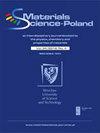Role of crystallographic orientation in material behaviour under nanoindentation: Molecular Dynamics study
IF 1.3
4区 材料科学
Q4 MATERIALS SCIENCE, MULTIDISCIPLINARY
引用次数: 0
Abstract
The mechanical properties of materials can be analysed under deformation conditions by various laboratory tests. However, such experimental investigations become extremely complicated and often even impossible at the lower length scales where the arrangement of the atomic planes is considered. In this case, computational materials science is a robust alternative to extend the capabilities of laboratory tests. Therefore, the molecular dynamics technique was selected in the current work to evaluate the role of the local grain crystallographic orientation during nanoindentation testing. A pure aluminium sample was selected as a case study. For the sake of clarity, two distinctively different crystallographic orientations cube {100}<001> and hard {110}<011> were investigated in a set of arrangements: monocrystalline, bicrystalline, and polycrystalline. The influence of the substrate and the neighbouring grains on the material response to local deformation was evaluated. The research used two types of indenters: spherical and sharp-tipped. Results obtained were analysed with respect to the arrangement of atoms and load-displacement curves. This research proved that the role of crystallographic orientation in material behaviour under nanoindentation should not be neglected during the interpretation of data from this test.晶体取向在纳米压痕下材料行为中的作用:分子动力学研究
材料的机械特性可以通过各种实验室测试在变形条件下进行分析。然而,在考虑原子平面布置的较低长度尺度上,此类实验研究变得极为复杂,甚至往往无法进行。在这种情况下,计算材料科学是扩展实验室测试能力的有力选择。因此,本研究选择了分子动力学技术来评估纳米压痕测试过程中局部晶粒晶体学取向的作用。我们选择了一个纯铝样品作为案例研究。为了清楚起见,在单晶、双晶和多晶的一组排列中研究了立方体{100}<001>和硬质{110}<011>两种截然不同的结晶取向。评估了基体和相邻晶粒对材料局部变形响应的影响。研究使用了两种类型的压头:球形和尖头。对所获得的结果进行了原子排列和载荷-位移曲线分析。这项研究证明,在解释纳米压痕试验的数据时,不应忽视晶体取向在材料行为中的作用。
本文章由计算机程序翻译,如有差异,请以英文原文为准。
求助全文
约1分钟内获得全文
求助全文
来源期刊

Materials Science-Poland
MATERIALS SCIENCE, MULTIDISCIPLINARY-
自引率
18.20%
发文量
18
期刊介绍:
Material Sciences-Poland is an interdisciplinary journal devoted to experimental research into results on the relationships between structure, processing, properties, technology, and uses of materials. Original research articles and review can be only submitted.
 求助内容:
求助内容: 应助结果提醒方式:
应助结果提醒方式:


